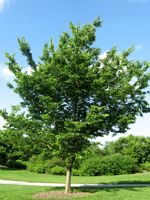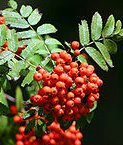Mon-Fri 9am - 5pm Mountain time
Common Hackberry vs European Mountain Ash
Celtis occidentalis
Sorbus aucuparia
NOT AVAILABLE THIS SEASON - MIGHT RETURN
The Common Hackberry is a medium-sized deciduous tree that resembles the American Elm but is immune to Dutch Elm Disease. They are versatile and can adapt to a variety of growing conditions.
It produces purple-red, berry-like fruit with a large seed in the center. Both the sweet flesh, which tastes similar to dates, and the crunchy seed are edible. The fruit remains on the tree throughout the winter, offering a valuable food source for birds and other wildlife.
The Common Hackberry can also be a great addition to a pollinator garden. The tree itself is a host for the larvae of several butterfly species and the flowers provide a source of pollen and nectar.
European Mountain Ash is an attractive, ornamental tree. This medium-sized tree produces tiny white-yellow flowers in the spring and decorative clusters of small red/orange berries in the summer. Its bitter fruit is often used to make Rowan Jelly, is a traditional garnish for wild game and venison. Ideal for residential lots, European Mountain Ash will attracts birds to your property.

